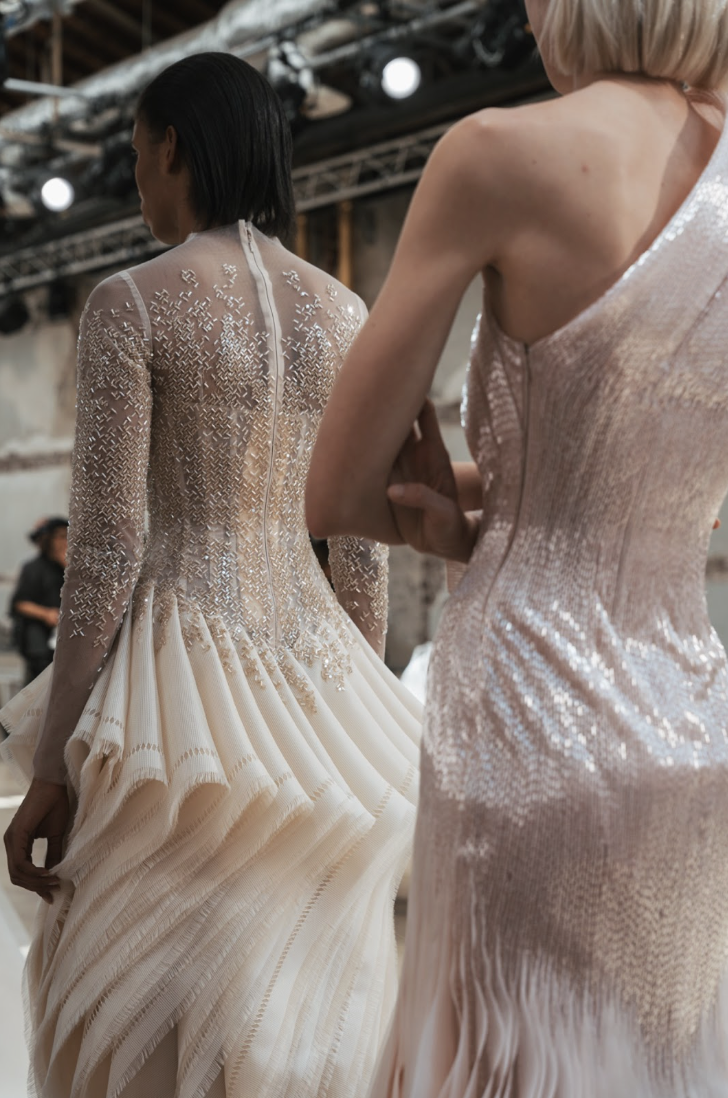The Invisible Hands Behind Haute Couture
Courtesy of Rami Al Ali
Have you ever looked at a couture garment and felt an overwhelming urge to touch it? You’re not alone. There’s something intrinsically tactile about haute couture—whether that’s a shimmer of a fabric or a meticulously placed bead. On the runway, every detail dances in the light and demands to be seen. After all, beneath each couture creation, lie hours and hours of human work. In a world of mass-produced and machine-made fashion, tactility sets couture apart. The human touch enables couture to come alive.
A quiet moment before the curtains ascend. Layers of pleated fabric, carefully stacked. Hand-embroidered tulle clings like a second skin. Sequins catch the daylight. Each stitch is a whisper of the human hand—a tacit confidence that the makers have done their job. The show will be beautiful.
Courtesy of Rami Al Ali
Beauty’s in the details… but what is haute couture, really? Haute couture refers to high-end, custom-fitted fashion that is crafted entirely by hand from start to finish. The term is protected by French law and reserved for a select number of labels. As opposed to ready-to-wear, mass-produced and standardized, couture is personal. Intimate. Human.
Courtesy of Rami Al Ali
Behind each elaborate piece hides a troupe of artisans known as les petites mains, which in French, literally means “the tiny hands”. These tiny hands possess a magical knack—for embroidery, beading, sewing, pattern-making, draping, and above all, patience.
Courtesy of Rami Al Ali
In a society ruled by screens and speed, there is something undeniably sacred about a patient stroke of a hand. Today, touch has been stripped from much of what we wear. Similarly, human faces have faded in conversations with chatbots and online exchanges devoid of physical connection. Where AI and algorithms blur our words into a sameness, even the human voice has grown faint. Technology has simplified life in many ways, but it has also chipped away at something vital. Something human. Something that makes us feel.
Photo from the Rami Al Ali Show by Mackenzie Ostrowski
It makes sense then, that now more than ever, we crave tactility. We want to experience something that reminds us of our humanness and not something that strips us of it.
Courtesy of Rami Al Ali
Rami Al Ali’s Guardians of Light – The Living Craft of Damascus couture collection did just that. It reminded us not only of our humanness, but that we all, as humans, come with stories waiting to be told. On July 10th, Al Ali made history as the first Syrian designer ever included in the official calendar of Paris Haute Couture Week. Through Guardians of Light, he paid homage to Syria’s beating heart—Damascus—and its hidden, timeless beauty. Through couture, he echoed the historic spaces of the city, “once alive with calligraphers, woodworkers, metal artisans, and weavers.” Using fashion as his language, he emulated the city’s aliveness. And we see it. Feel it. Almost touch it, on Al Ali’s runway.
Courtesy of Rami Al Ali
With the help of the human hand, Al Ali invited us to witness more than just a fashion show. He invited us to feel the pulse of a city and its people. He encouraged us to reach out and touch: sequins arranged like Iznik tiles. Brocades hand-stitched with embroidery. Beads mimicking rhythmic geometry. And within this tactility, each thread traced back to Syrian heritage—each stitch a tribute to craft kept alive.
Courtesy of Rami Al Ali
Damascus, built and adorned by its citizens, tells a tale of manual labor and the spectacular craftsmanship that sustains it. Haute couture, too, is a time capsule of human labor, care, and emotion. Tactility is omnipresent. In the making, in the preparation, and most profoundly, in the viewing.
Courtesy of Rami Al Ali
It’s no coincidence that we stare at the runway and feel an overwhelming urge to reach out. We are innately tactile beings. We kiss. We hug. We hold hands. In a world automated, eroded, and flattened into sameness, we need texture. Because in texture, we find proof of human life. We reach out—and feel the touch of a human hand.








